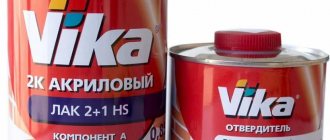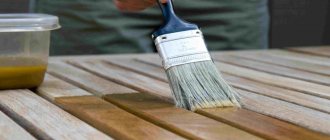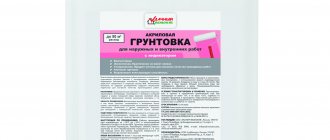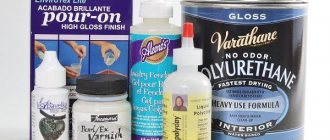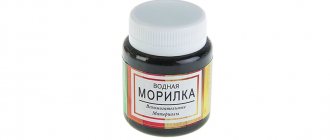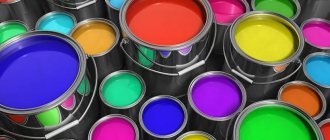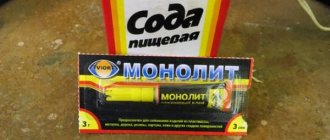One of the effective ways to protect the surface from the influence of external factors, such as moisture or minor mechanical damage, is to create a varnish coating. Water-based acrylic varnish, also known as polyacrylic, copes well with this function. It also adds additional aesthetics to the appearance of any structure. Taking into account the modern trend towards the use of environmentally friendly materials, this type of coating is one of the most popular finishing compositions.
Composition of acrylic varnish
Modern types of water-based acrylic varnishes are produced ready for use.
The basis of acrylic varnish is a water-dispersive solvent and small fractions of plastic dissolved in acrylic.
The composition also includes antiseptic components that protect the coating from moisture and pests, and a plasticizer that provides increased strength to the composition after drying. The result is a transparent layer that provides a spectacular appearance and is practically odorless.
What are acrylic paints and varnishes
Acrylic paint and varnish materials used for exterior or interior work are made from polymers
Acrylic paint and varnish materials used for exterior or interior work when processing wood products of various species, metal, glass, stone and many other surfaces, including soft fabric, are made from methyl, butyl or ethyl acrylates - polymers formed by esters of acrylic, methacrylic or cyanoacrylic acid.
Acrylic polymers were first produced in 1952 by one of the leaders in the manufacture of American paint and varnish products, which was developing technology for the production of a new type of material that could compete with nylon, which was popular in those years. The resulting material was easy to paint, was resistant to ultraviolet light and the effects of solutions of acids and alkalis, and when completely dry, practically did not react to prolonged exposure to water.
And who, if not the leader in the production of paints and varnishes, can apply these properties to obtain durable varnishes and paints used in industry and everyday life. Acrylic paints and varnishes are widely used in the automotive industry as factory coatings and repair systems, in construction for interior finishing, and in the creation of durable plasters and paints for exterior use.
The resulting polymer materials are highly soluble in various types of solvents. Organic solvents allow you to adjust the drying time and temperature conditions for using paints, and water-based varnish is practically odorless and can be used for treating surfaces in children's institutions and painting toys. It is easy to apply to the surface, and after drying it can only be removed with a special solvent.
Varnishes and paints based on acrylic polymers produced by various manufacturers have excellent protective properties.
Varnishes and paints based on acrylic polymers produced by various manufacturers have excellent protective properties, which determine their wide distribution:
- Good adhesion to most types of materials, with the exception of some “fat” polymers such as polyethylene;
- Short drying time;
- Compliance with the latest environmental requirements;
- Resistant to water and most solvents after complete drying;
- High strength and elasticity of the resulting film;
- The ability to be absorbed into wood fibers, creating a thick protective layer;
- Long service life, reaching 10-15 years when covering external surfaces.
As reviews show, it is high environmental friendliness that consumers put first when choosing paints and varnishes.
Advantages and disadvantages of acrylic varnishes
Like any paint coating, polyacrylic varnish has its pros and cons. There are much more of the former than the latter.
Perhaps the main feature that explains why acrylic varnish is so popular is its sale in a ready-to-use state. This significantly reduces preparation time, which is very important for large-scale finishing work.
Advantages
In addition, the main advantages that distinguish acrylic varnish include:
- The ability to create decorative coatings on bases made of any types of materials, including metal and brick;
- Resistant to all types of solvents. Polyacrylic varnish is easily dissolved with water during application, but after drying it forms an extremely durable coating that is resistant to any influences;
- High resistance to temperature changes, moisture and thermal conductivity;
- Colorless acrylic varnish retains its transparent properties for several years from the moment of application;
- High compatibility with water-based paints;
- Environmental and fire safety, as well as antiseptic qualities of the composition.
Flaws
If we do not take into account possible errors during application associated with inattention and the human factor, we can say that water-based acrylic varnish has practically no obvious disadvantages. However, before applying the coating, be sure to check the expiration date indicated on the container label. Prolonged storage of the composition at low temperatures can significantly reduce its basic properties - elasticity and ease of application.
Well, as another disadvantage we can mention the high cost. So, for example, the price of glossy colorless acrylic varnish from the leading manufacturer Tikkurilla can reach up to two thousand rubles per liter. However, there are also more economical analogues from domestic ones or Neomid.
No. 1. What are the differences between different wood varnishes?
Varnish is a viscous product consisting of a solvent, resins and polymers. After application to the surface, the solvent evaporates, leaving a dense, durable film. This barrier protects the tree from various kinds of negative factors. Since wood was previously the main building material, the first varnishes appeared in the 12th century. It was the invention of a German monk, and the composition of the protective substance was kept secret for a long time. Attempts to develop a means to extend the life of wood have been made constantly. Thus, in the 15th century, oil-type compositions appeared in England, and later in Holland and Portugal they began to produce resin-based varnishes.
Since then, the range of such products has expanded significantly, compositions with specific properties have appeared, so today you can’t just go to the store and buy the first wood varnish you come across - it is important to take into account a lot of nuances of different compositions, otherwise you may not only fail to protect the material, but also harm it
When choosing a wood varnish, you should take into account the following factors:
terms of Use. Outdoors, the material is affected by factors such as high humidity, constant temperature changes and ultraviolet radiation, so the composition for protection must be selected accordingly - only wood varnishes are suitable for outdoor use. As a rule, the manufacturer indicates on the packaging the conditions under which the composition can be used. Parquet, furniture and wall finishing materials can be safely coated with wood varnish for interior work;
wear resistance. It is not always possible to cover the floor with the same composition as the furniture, since the load on the surface will be completely different. If even the least resistant nitrocellulose varnish is suitable for furniture and other wooden objects that are not subject to heavy wear, then for flooring it is necessary to take more durable compounds;
toxicity. Most modern formulations have an unpleasant, pungent odor when drying, as they contain organic solvents. Of course, this smell will disappear when the varnish is completely dry, but until then you will, at best, have a headache, and at worst, get serious poisoning. Polyurethane, acrylic, polyester varnishes and nitro varnishes are applied with special protective equipment in carpentry workshops or non-residential premises. After drying, all these compounds become safe. If the work needs to be carried out at home, and the household members are not going to leave anywhere, then it is better to take the least toxic composition - these are water-based varnishes, they are practically odorless;
drying time. A layer of varnish can dry from 6 to 72 hours and sometimes longer. Water-based varnishes and oil-based varnishes take the longest to dry; alcohol-based and nitrocellulose varnishes take 20 minutes or more. According to this parameter, all compositions are divided into slow- and quick-drying. Take this characteristic of the varnish into account when calculating the duration of the work;
resistance to high temperatures. It makes sense to apply heat-resistant varnishes to wood in rooms where the risk of fire is increased
It is important not only to choose the appropriate composition, but also to properly expose the surface with it, because the result largely depends on the application technique;
shine. Thanks to the varnish you can get a glossy or matte surface
The choice in this case is based only on aesthetic preferences, since performance qualities do not depend much on the degree of gloss. Gloss gives visual volume, and the matte surface can highlight the beauty of the wood. The degree of gloss is determined as a percentage of the reflected light flux. For example, high-gloss varnish reflects more than 90% of light, glossy varnish reflects 80-90%, and matte varnish reflects less than 10%. There are also semi-gloss and semi-matte compositions, so there is a wide choice;
varnish components. For doing the work yourself, one-component varnishes are best suited, those that are simply applied and form a protective film by evaporating the solvent. Professionals often use two-component varnishes, in which the protective film is formed as a result of a chemical reaction between two substances. As a rule, such compositions are more durable;
need for primer. Self-priming varnishes can be applied directly to wood. Other compositions require preliminary preparation of the surface: if you do not prime it, you may soon experience peeling of the varnish, the appearance of cracks and craters.
You can also find tinting varnishes on sale. With their help, you can give the wood the desired shade or even completely change the color. However, the classic option is still transparent varnish, which allows you to preserve the original wood pattern.
Types of acrylic varnishes
Painting specialists classify acrylic varnishes according to various characteristics and characteristics.
By composition
From a formulation point of view, the following types are distinguished:
- monocomponent varnishes , the main component of which is acrylic. It is supplemented with various stabilizers and antiseptics, as well as plasticizers. Such a mixture forms a reliable layer, but is not very resistant to moisture, so the main range of use of one-component water-based acrylic varnish is interior decorative and finishing work. As an example - acrylic varnish for decorative plaster;
- a two-component acrylic varnish that uses a combination of polyurethane and acrylic bases. This composition is usually designated by manufacturers as acrylic polyurethane varnish. Adding polyurethane to the composition increases the elasticity and strength of the final coating, resistance to mechanical loads, which makes it suitable for flooring in public places with a large influx of visitors
According to the appearance of the coating being formed
Modern manufacturers offer a wide selection of different brands of polyacrylic varnishes, differing in the external characteristics of the coating being created:
- glossy colorless acrylic varnish - a composition that can give an expressive shine to any surface;
- matte colorless acrylic varnish forms a rough texture reminiscent of velvet on the treated surface;
- universal acrylic varnish, also called semi-matte, forms something between a glossy finish and a matte surface.
Application
How to apply the viscous substance? Can I do this myself? In order not to spoil the tree, you need:
- clear the work area of debris, dust, and grease;
- sand the area to be coated with the substance;
- apply a primer to the work area to reduce varnish consumption;
- take a technical break so that the surface is completely dry;
- cover the area with white spirit with varnish (diluted);
- apply varnish in two layers;
- take a technical break - 2-3 days.
The process is quite simple. If you believe consumer reviews, then the work can be done not only by men, but also by women. Working with it is easy and pleasant: there is no pungent odor...
Areas of application of water-based acrylic varnishes
The high quality standards that water-based acrylic varnishes meet provide a wide range of possible applications. Similar compositions are used both in repair and construction, as well as in decorative and finishing works.
Let's look at the main areas in which varnish coating is used.
- For interior and exterior work in wooden houses, the most popular are glossy colorless and panel acrylic varnish. They are effective from an aesthetic and practical point of view, as they highlight the natural beauty of natural wood and reliably protect it. The coating can be washed regularly, it is environmentally friendly and does not pose a danger to the human body.
- Finishing of interior elements. Tables, chairs, sofa frames, stair railings - any pieces of furniture and other structures made of wood will last much longer if acrylic-polyurethane varnish is used for their treatment. The strength of the composition prevents the occurrence of minor damage, which is why polishing from the moment of application will be required no more than once a year.
- Strengthening the finishing coating of walls . One of the reasons why water-based varnish is so popular is its versatility in terms of surface material. Universal acrylic varnish is applied to painted walls, paper wallpaper, tiles and tiles. In all cases, the main goal is to create an additional protective layer that preserves the appearance of the interior walls.
- Parquet processing . As a rule, dense and rough boards are used to create parquet flooring, so for their processing it is better to choose matte colorless acrylic varnish on a polymer-acrylic base. It will provide a more durable coating that can withstand intensive use. Considering how long acrylic varnish takes to dry, you can treat all the floors in one room in just one day.
- To enhance the decorative effect of wooden or other products. Modern water-based acrylic varnishes are an effective material for the final stage of processing wooden or other products, capable of highlighting their beauty. When applied to wood, the composition actively penetrates the pores of the top layer and is securely fixed to the base.
- Protection of paintings . Don’t be surprised, professional artists, trying to extend the life of their masterpieces, often use a transparent acrylic composition as a protective layer. It does not affect the brightness of colors and protects them from fading. By the way, another option for creative use of acrylic varnish is decoupage. This design find involves decorative finishing of the interior with small drawings and patterns on paper.
Varieties and characteristics
Varnish is a substance produced in the form of a mixture of polymers, solvents and film-forming resins.
The film formed by varnishes can be different - transparent or have shades. Tikkurila products are used to treat surfaces in homes, baths and saunas, terraces, boats and yachts. Some varnishes can be used to treat concrete and brick surfaces, and the consumption of varnish will differ from its consumption when covering wooden surfaces. Depending on the specific application, the following main groups of Tikkurila varnishes are distinguished:
Lacquer Aqua
A group of water-based, tintable acrylate-based varnishes. These products perfectly protect wooden panels, lining and any boards.
An important positive point is that all products in the Lacquer Aqua line do not have a strong odor, so they can be used in any interior space, although water-based varnishes are not used for treating furniture and floors. "Lacquer Aqua" effectively protect wooden surfaces from temperature changes, darkening and even moisture.
Water-based interior varnish is suitable for any wood and can be easily tinted.
Kiva
Buyers often choose this tintable water-based acrylate varnish for its excellent qualities (it does not turn yellow) and favorable price. Kiva is used indoors for varnishing furniture, walls, ceilings and doors. Stained and painted surfaces can also be treated with Kiva products. Since the coating does not turn yellow, it allows you to preserve the color and texture of the wood for many years.
Euro Kiri
They are particularly wear-resistant, making them widely used for parquet and other wooden floors. Reliable, load-resistant coating will cope well with frequent floor washing and exposure to detergents.
Oksalakka
Special varnish for processing knots. If you are concerned that after painting the wood, brown spots of resin may appear on the surface in the places of knots, then you need the special “Oksalakka” product!
This is a special composition that will not allow the resin to seep through the painted surface; simply apply it with a brush to the knots before the final painting.
Paneeli Assa
A line of acrylate varnishes used for interior work when treating wooden and brick walls. If you want to protect your ceilings and walls from damage, then Paneeli Assa is the best choice.
There are no hand marks or small scratches from sharp objects on the protective film formed when the product is applied. The color of the composition is initially white, but as it dries it brightens and becomes transparent.
It should be noted that the “Paneeli Assa” line is quite diverse and includes special varnishes for light wood and special protective agents that repel water and dirt.
Parketti Assa
A line of reliable water-borne polyurethane-acrylate varnishes. These products will protect your wooden floor from scratches, wear and other damage for a long time, while surfaces treated with these varnishes look environmentally friendly, natural and impressive.
Taika Glow
This is a unique polish that glows in the dark. Wherever it is used - in interior decoration of clubs, cafes and cinemas, in bedrooms and children's rooms! It is environmentally friendly, so you can involve children in creativity.
Unica Supe
Wear-resistant product, suitable for indoor and outdoor use. It is also called yacht or deck, as it is widely used in painting boats. Unica Super varnish is used to cover window frames, floors and doors, outdoor furniture and much more.
All products in the Unica Super series are urethane-alkyd and dry fairly quickly. The product slows down the “aging” of wood from exposure to sunlight and is not afraid of contact with water, and also protects the wood from mold, cracking and fungus.
In order not to be mistaken with the amount of material required, you should make a calculation in advance and find out how many cans of varnish you will need
Please note that the packages always contain data indicating how many square meters can be varnished. To do this, you need to calculate S (room area) and correlate the information obtained with the data on the varnish packaging
General tips for applying polyacrylic varnish
One of the mandatory conditions that must be met for high-quality painting is positive temperature inside the workroom and high air humidity - not lower than 50%. Otherwise, the quality characteristics of the coating may deteriorate significantly.
Before painting, you should stock up on gloves and a protective gown to prevent the composition from getting on your skin and everyday clothes. If a few drops do spill in an unnecessary place, you can wipe off the acrylic varnish before it dries with plain water. After drying, it is better to use professional solvents or gasoline, but you need to be careful with sensitive surfaces. For example, the top layer of laminate, made of polyurethane, can come off along with a stain of accidentally spilled acrylic varnish.
It is best to apply water-based varnish using a roller - it is easier for them to handle large and even surfaces. The brush is best used for small or complexly shaped areas. Aerosol acrylic varnish in cans can be used for painting walls or other large objects. Taking into account how long acrylic varnish takes to dry (2-4 hours), this can be the optimal solution for quickly treating large rooms.
It is worth remembering that the thinner the applied layer, the more impressive the surface looks. In addition, this optimizes the consumption of acrylic varnish per 1 m2 - on average, it takes about 110 grams of composition to cover one square in one layer.
Many beginners ask whether acrylic composition can be applied to alkyd paint or varnish. Theoretically, yes, but it’s better not to do it. The reason for this is the low compatibility of the compositions of the two coatings, which leads to swelling, unevenness and subsequent loss of the top layer. So this combination is not recommended.
Another popular question is “why does acrylic varnish stick?” The answer, alas, is very simple - you came across a low-quality composition. A high-quality acrylic-based composition should completely lose its sticky properties after complete drying.
Some advice from experts
The water-based dispersion varnish can cause deformation of wood fibers. As a result, after varnishing the surface may appear rough. To avoid this, there are two simple techniques:
- the surface is pre-wetted and ground before priming;
- Abrasive processing occurs after the rough coating has dried with diluted varnish.
Hiding defects in varnished film using polishing materials is only possible when working with matte compounds. If the varnish is glossy, then the sanding marks will be visible under the transparent dry residue. To avoid this, you will have to remove the faulty layer using a special remover or a hair dryer. And then repeat all the work again.
Means for removing old and fresh paint coatings Source stroy-podskazka.ru
Manufacturers often indicate an intermediate drying time of layers of 30 minutes or two hours. This is enough to harden the dry residue and avoid stickiness. But it is better to withstand the entire 12-24 hours. Then it will be possible to promptly identify possible defects, eliminate them and continue work.
When working with acrylic varnish, experts recommend sanding after each layer, except for the finishing layer. The process looks like this:
- the surface is moistened;
- sand with fine-grained sandpaper;
- dust and dirt are removed with a damp cloth after the object has dried.
This procedure is especially relevant for glossy finishes. Acrylic varnish has little contact with smooth and dense film. Often, the situation is overcome with the help of matte compositions for preliminary application.
Materials with different degrees of gloss Source yandex.net
Applying varnish to a wooden surface
The priority step before applying acrylic varnish is thorough surface treatment. You need to remove everything from it that could interfere with the formation of an even layer. The processing takes place in several stages, the number of which depends on the characteristics of the base for painting:
- Cleaning. If the surface has already been varnished, then in addition to removing various dirt and grease stains, you will need to remove the previous layer of varnish. Before removing the old varnish coating, you need to make sure that the procedure will not damage the base (this is especially true for parquet floor coverings, the boards of which can crack under intense impact). Sometimes this can be quite simple; but in order to remove the old acrylic varnish, you will have to work hard - it is better to stock up on abrasive paper and a sanding machine.
- Grinding . In order to achieve a perfectly even wooden base, you can use the “wet” method - wet the wood and walk it hard with sandpaper. The primer mixture and acrylic varnish applied after this will form a “mirror” coating.
- Primer. The cleaned surface will need to be impregnated with a special composition that will eliminate all irregularities invisible to the eye.
If the finished composition seems too viscous, or wood is being processed for the first time, you can dilute the acrylic varnish with water. However, it must be remembered that the maximum proportion of solvent should not exceed 1/10 of the total mass. This composition is ideal for the first layer, but the second and third layers should already be undiluted.
Types, brands and price
Retail chains offer a huge variety of acrylic water-soluble paints and varnishes
Retail chains offer a huge variety of acrylic water-soluble paints and varnishes for any type of work, from numerous domestic and foreign manufacturers. Despite the external similarity, the price of different samples may differ significantly. Let's try to understand all this abundance in order to choose the necessary product.
Glossy, semi-gloss or matte
Glossy varnishes give the surface a unique shine
To create the required appearance and high-quality protective film on the surface of wood or metal, manufacturers offer glossy varnishes with a gloss level of 64-72%, semi-gloss - up to 49%, as well as matte and semi-matte compositions with a gloss level of 26% or less. Regardless of the degree of gloss, acrylic varnishes, penetrating deeply into wood pores, are a high-quality product for the final processing of wood. Glossy varnishes give the surface a unique shine, while matte varnish emphasizes the beauty of the wood without changing its color, but only creating a durable invisible protective film.
One or two component
The most common in the retail chain are one-component water-based acrylic varnishes.
The most common in the retail chain are one-component water-based acrylic varnishes, completely ready for use. They have a lower price and are easier to work with even for an inexperienced craftsman. The “lifetime” of such compositions is limited only by the complete drying of the solvent, that is, water. Two-component varnishes are manufactured to impart special properties to a polymer composition designed to protect wood under conditions of high humidity or abrasion load.
These materials contain additional additives that require the addition of a hardener for polymerization. Their price is higher and it is more difficult to work with them. After mixing the components, the period of use of such varnish is limited, which imposes certain requirements on the speed of work and the qualifications of workers.
Manufacturers
Retail chains offer a large amount of water-based acrylic varnish from a wide variety of manufacturers.
Retail chains offer a large amount of water-based acrylic varnish from a wide variety of manufacturers. Here are both famous foreign companies and domestic manufacturing companies, stepping on the heels of their foreign competitors. The price of imported goods is much higher, but this does not mean its high quality.
Famous brands “Marshall”, “Tikkurila”, “Dulux”, “Alpina”, “Akzo Nobel” cost three times more than the same high-quality varnish made from high-quality materials, from domestic ones, “Tex” or “Neomid”, the price of which is 10-15 USD. per kg.
When buying water-soluble varnish, you should keep in mind that there are many products with a “narrow” specialization. Baths and saunas have their own materials, and parquet has its own materials, with the necessary properties. Accordingly, their prices differ, even within the same brand.
Water-based acrylic paints and varnishes are widely used in construction and repair work.
Water-based acrylic paints and varnishes have found wide application in construction and repair work, in painting industrial equipment in enterprises with increased environmental requirements, and even in painting the bodies of modern cars, replacing varnishes and paints based on organic solvents that are hazardous to health. As reviews show, approximately 60-65% of buyers choose water-soluble materials.
Manufacturers
Many companies in Russia and abroad produce acrylic varnishes. In the modern market, customers are offered products from different brands. Below are the most famous of them.
"Chief Technologist"
The “Chief Technologist” line of paints and varnishes is produced by a company from NovBytKhim. A significant advantage of the manufacturer is the presence of its own research laboratory. Acrylate varnish for wood is suitable for indoor and outdoor work in the average Russian climate. It can be used to cover already painted surfaces using water-soluble paints.
The coating dries within 2 hours at room temperature and normal humidity (40-60%), and is consumed economically. Manufacturers recommend using paintwork materials at temperatures above 10 C. After applying each layer, you must allow the previous one to dry for an hour. When closed, the composition is stored for up to two years. Varnish is produced in buckets of 0.5, 1, 2 and 10 kg. The color range is represented by 12 shades of the most popular tree species (maple, beech, pine and others).
VGT
VGT products receive good customer reviews. Two factories have their own laboratory and produce a wide range of materials. VGT varnish is intended for antiseptic surface treatment. Due to its composition, it penetrates deep into the base, ensuring the safety of the surface. It is applied in a thin layer in the form of an elastic film.
It can be applied with any tools, it is characterized by low consumption (from 100 to 160 g/sq. m). The layer stops sticking within 1 hour. Complete drying occurs after 2 days. The composition is presented in 12 shades. It is recommended to apply it at a temperature of 7 degrees C and above, as well as sufficient air humidity. It is stored under normal conditions for 24 months. Available in 0.9, 2.2 and 9 kg formats.
Tikkurila
Tikkurila is a well-known Finnish brand with a century and a half history. Since 1995, the company has been operating in Russia. The products have long gained popularity in the Russian and global markets for paints and varnishes. Finnish quality makes Tikkurila varnishes in demand in the construction market. Acrylic compositions are presented in several versions.
There are glossy, matte, semi-gloss textures. The varieties have good protective properties; they are perfectly leveled when applied. Material consumption is moderate: from 8 to 14 square meters. m/l. The trademark varnish dries completely in 24 hours. On store shelves it is sold in cans of 0.9, 2.7 and 9 liters. The only drawback of this product is the high price.
"Lakra"
The group is one of the leaders in the Russian production of acrylic varnishes. Thanks to the production of products in many European countries, their quality meets the highest standards. These compounds are applied with a brush or spray gun; they have a low consumption (from 8 to 14 sq. m/kg). The range includes all texture options, the products have an attractive price and are sold in two versions: 2.5 and 10 kg.
The sealed product can be stored for up to two years. It dries after application after 5 hours and becomes hard after another 3 hours. The surface is completely ready for use after 7 days. The company's coatings have good performance characteristics.
Eurotex
Acrylic varnish for wood Eurotex is a product of a Russian brand. It guarantees protection of the array from various kinds of microorganisms, moisture and temperature fluctuations. This product can be used for external and internal work. The paints and varnishes are packaged in packages of 0.9, 2.5 and 9 kg. Acrylic varnish of the brand is economically consumed: 1 kg is enough to process 20 square meters. m of surface.
The company's products receive a lot of positive feedback from buyers and craftsmen. Among other comments, the durability of the applied layer is noted.
Pinotex
Pinotex products are used for interior and exterior wood surfaces. The material is sold in containers weighing 1, 3 and 10 kg. The acrylic composition is consumed economically: it can cover up to 18 square meters. m of base with one kg of mixture. The manufacturer focuses on the high environmental friendliness of the product and its safety, which is reflected in the rather high cost. The glossy varnish has antiseptic additives, is environmentally friendly and is easy to apply using any type of tool from a spray bottle to a brush. Products are constantly being improved and technological characteristics are improved.
Required Tools
Preparing the surface for applying acrylic varnish is the main and important step in the work. First you need to clean everything from dust, dirt and grease. In case of re-application, the old layer must be removed and the part to be varnished must be sanded. The first application to wood is characterized by the use of three layers: the first is varnish diluted with a solvent by 10%; the second and third are undiluted varnish.
It is recommended to apply acrylic coating using a special roller. Professionals do not recommend using a brush when it comes to large sizes of the surface to be varnished. The interaction of the substance with the skin is unacceptable, so work should be carried out with gloves.
When decorating a room and its elements, the idea of adding color to the varnish may arise. Of course, you won’t be able to achieve bright colors, but tinting makes it easy to give your favorite piece of furniture a new shade.
Useful tips
To optimize varnish consumption, surface priming is recommended.
To do this, you can use a water-based primer or tinted impregnation. If the goal is a “mirror” surface, you need to “wet” sand before priming, which means sanding wet wood. Also, the specularity is imparted by treating all layers of varnish (except the last one) with fine sandpaper. When choosing a paint product, you need to take into account the presence of defects on the surface. For example, glossing visually increases existing unevenness, while a matte background conceals it.
Acrylic can only be diluted with clean water.
Moreover, the volume of water should not exceed a tenth. Do not dilute water-based varnish with organic solvents or mix it with drying oil or other varnishes. Violation of these rules leads to wood losing its natural structure. Varying shades in a can of tinted varnish are normal. However, the composition must be stirred well before use. Acrylic varnish cannot be used if the air humidity is less than 50%, since in this case it dries too quickly, which will cause defects. Do not varnish oily surfaces. They must be pre-treated with soapy water and then dried. To give the wood a noble shade, it must be treated with tinting impregnation, and after that - with colorless varnish or varnish mixed (5%) with water impregnation. When applying tinted varnish, it is necessary to ensure that the layer is even, because if it is too thick, it will make the surface look dark. Several thin layers will contribute more to the uniformity of the coating rather than one thick one. To add darkness, you can first make the first layer very thin, and the next one should be colorless. If the goal is uniform varnishing, the old layer of varnish needs to be completely stripped off or a dark varnish should be used. To even out the absorbent qualities of the wood, it is primed with a couple of layers of colorless impregnation or then tinted.
Before starting paint and varnish work, it is recommended to try your skills on some test product. It is better to move on to responsible tasks as you gain some experience.
Varnishing functions
You can varnish walls made of artificial stone
With the help of varnishing, a whole range of different goals are achieved:
- Strengthening the varnished surface. In this case, varnishing plays the role of an adhesive composition that holds together small weakly adhering or peeling elements.
- Protective function. The varnished surface has increased resistance to aggressive external influences - household chemicals, changes in humidity, temperature, etc. After varnishing, surfaces painted with non-waterproof compounds can be subjected to wet cleaning without fear of washing off the paint.
- Antiseptic effect. Protects the treated surface from the development of fungi and mold.
- Preserving color saturation and brightness. By covering a painted surface with a thin layer, you create a translucent film over it that “cuts off” excess ultraviolet radiation. Thus, the sun's rays become less destructive to the pigment of coloring compounds.
- Decorative qualities. Decorative varnish, depending on the type, can give the surface treated with additional decorative properties: shine, dullness, colored tint, etc.
Siltek-1
Thermolac Siltek-1 allows you to paint the surface of the stove structure without using a chemical primer. When several layers of varnish are applied, the treated surface acquires an aesthetic appearance.
The main disadvantage of this product is its long drying time. On average, this will take about 5 hours.
In addition, a high consumption of the composition is noted here, since it is absorbed into the deep layers of the brick. The photo of heat-resistant varnish for the stove shows popular brands of chemical coating.
